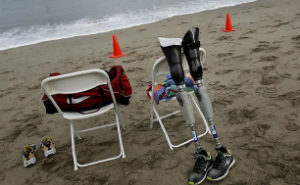When your prosthesis fits correctly, you forget about it. And that’s the goal of prosthetics: to facilitate your everyday activities painlessly and seamlessly. So, when do you need a prosthetic re-fitting?
However, unlike your prosthetic limb or device, your lifestyle, and body change over time. This means that you’ll need regular check-ins and some fine-tuning to ensure that your prosthesis remains well-fitted to your residual limb and that it’s functioning properly.
A poorly fitted prosthesis can lead to skin irritation, site soreness, and, in the worst cases, infection. But how do you know exactly when it is no longer a proper fit? To help prevent symptoms and catch issues early on, let’s explore the top signs that it’s time for a re-fitting or replacement of your prosthesis.

When Is Prosthetic Re-Fitting Needed? Signs & Symptoms
1. Natural Aging/Visible Wear and Tear
Limb prosthetics don’t last forever. And when you use them daily, they work just as hard as your natural limbs, resulting in natural wear and tear.
Depending on your level of activity and the quality of your prosthesis, its lifespan will vary. Over time, you may find that the prosthetic socket or the prosthetic limb itself starts to feel a little off. This is especially true for larger prosthetics, such as a whole arm or leg. The more use they see, the faster they wear out.
Regular maintenance can significantly extend the lifespan of your prosthetic device. Regardless, the average device and its components can only offer top performance for two to four years before they need replacement or major repair.
If you notice cracks, warping, or irregularities in your prosthesis, bring it in as soon as possible, before it causes injury or irritation. The sooner we address any issues with your prosthesis, the easier it will be to repair it.
2. Weight Change
Another common sign that you may need to revisit the fitting process is a significant change in your weight. When you lose or gain substantial weight, it can change the size of your residual limb, as well as your gait or the way you distribute your weight when you walk.
You may notice a change in the fit of the socket first. If it feels significantly looser or tighter than usual, it’s probably time for a re-fitting. While it’s normal for the size of your residual limb to fluctuate throughout the day (see more information on prosthetic socks here), if you notice a constant change in fit or pressure that worsens over time, make a fitting appointment with your prosthetist.
3. Change in Your Level of Activity
When ensuring your prosthesis is a good fit, one factor your prosthetist will consider is your activity level. For instance, if you live a highly active lifestyle, it’s likely your residual limb will expand during the day with increased circulation and pressure.
This is mostly true of lower limb prostheses. Activity levels will still affect the fit of an upper limb prosthesis, but not as drastically. If you have a lower limb prosthesis and are extremely active, your prosthetist will need to ensure the suspension system works properly and that the material used is as durable as possible.
If your activity level increases as you acclimate to life with your prosthesis, it may be time for a re-fitting to ensure your device is properly fitted and that you aren't causing damage to your residual limb.
4. Skin Irritation
With prosthetics, one of the first signs of a poor fit is skin irritation. Some discomfort is normal at first when you are getting used to the new sensations. But if you are experiencing rashes, bruises, open wounds, blisters, or sores, you should visit your prosthetist immediately for a re-fitting.
Sockets that are too tight or too loose can both cause damage to your skin, which will become painful and invite infection. In the long run, these minor irritations can turn into severe health issues.
5. Pain and Discomfort
If you are experiencing extreme pain or discomfort in your residual limb, the surrounding muscles, or the area where your limb connects to your prosthesis, it’s time to see the prosthetist.
Don’t act tough or wait for it to get better. Your user experience should be seamless and relatively pain-free. Remember, the goal of a prosthesis is to make your life easier – not harder.
What Is the Re-fitting Process Like?
If you think you may need a prosthetic re-fitting, your prosthetist will schedule an appointment for you. The process will be similar to your original fitting appointment.
You’ll sit with the prosthetist and explain your areas of concern. Be as specific and thorough as possible when describing your pain or the way the prosthesis feels when you’re wearing it.
Let them know if it feels like it’s wobbling, unstable, warped, brittle, or hollow. Describe the location and nature of your pain, and show them any lesions, bruises, or marks that concern you.
The more information the prosthetist has, the easier it will be to fix your issue.
Based on the information you provide, your prosthetist will assess the condition of your device and make adjustments accordingly. If they recommend major repairs or a replacement of the prosthesis, it may take a few days to get it back to you, so make sure you have the transportation help you need.
Contact Horton’s With Your Prosthetic Re-fitting Questions
Still not sure whether you need a prosthetic re-fitting? Contact Horton’s Orthotics & Prosthetics to schedule an appointment with one of our talented and compassionate team members.


